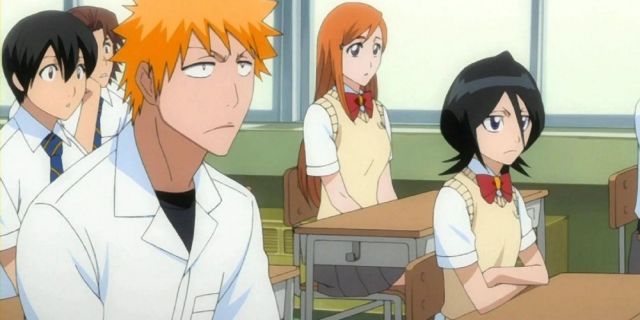Bleach is one of shonen’s legendary big three alongside One Piece and Naruto. Even if Bleach never reached quite the same heights as those series, it still offers many exciting storylines and anime elements that they don’t, such as isekai and reverse isekai. Bleach cleverly found a way to use isekai elements without fully committing to the isekai subgenre.
Protagonist Ichigo Kurosaki is a part-time isekai hero — a Japanese boy who visited the exotic Soul Society and later, the desert realm of Hueco Mundo. Before that, however, Ichigo’s good friend Rukia Kuchiki was a reverse-isekai heroine in all the right ways, adding quirks and unexpected tension to the story. In some ways, Rukia was almost a deconstruction of reverse isekai.
How Rukia Deconstructed Reverse Isekai in Bleach

The concept of reverse isekai is exactly what it sounds like: inverting the isekai trope where an exotic being visits Earth as a strange guest. A good Western example would be Stephen Spielberg’s E.T., and in anime, examples range from the charming seinen Miss Kobayashi’s Dragon Maid to The Devil is a Part-Timer!. In those series, the reverse isekai guest enjoyed their time on Earth, with Tohru the megadere dragon maid savoring her career as Kobayashi’s maid and exploring the wonders of modern Japan. It’s a refreshing change of pace, viewing ordinary modern life through the eyes of a fantastical creature who thinks toasters and the Internet are cool. However, in Bleach, the Soul Reaper Rukia Kuchiki turned this on its head to give the “Substitute Soul Reaper” arc some much-needed tension. It also helped set up the iconic “Soul Society” story arc.
Rukia didn’t stay in Karakura Town because she wanted to. Disaster struck when a Hollow named Fishbone D attacked, and Rukia transferred her Soul Reaper powers to Ichigo to win the day. Rukia then spent the following weeks in a gigai body courtesy of Kisuke Urahara, staying in the Kurosaki house for shelter and even attending Ichigo’s school. Rukia got used to human life and had no real complaints, but she also knew that she didn’t belong there. Rukia wasn’t a reverse-isekai tourist — she was a duty-bound Soul Reaper who longed to return home but couldn’t.
Rukia was already in trouble for lending her powers to a human, and her extended absence from the Seireitei and Squad 13 just made things worse. All this weighed heavily on Rukia, culminating in her running off one night to meet up with Lieutenant Renji Abarai to return home at last. Rukia was under arrest, but so be it. She had to take responsibility and put her duty first. When Ichigo tried to stop her, Byakuya cut him down, and Rukia willingly returned home and seemingly abandoned Ichigo.
All this partially deconstructed the idea of reverse isekai being a genre about a lovable exotic friend coming to visit, as Rukia didn’t belong there and knew it. Her reverse-isekai situation caused tension and trouble, not just humor, and this ended up being a key part of Bleach’s plot. It not only set up the “Soul Society” arc but was also a factor in Captain Sosuke Aizen’s plans. Overall, Bleach’s reverse-isekai sequence was a source of drama and suspense, not humor or novelty. However, it also had another, more positive role to play.
How Rukia Contrasts With Kon & Ichigo Kurosaki

Rukia’s reverse-isekai adventure wasn’t that much fun for her, but it did expand her worldview, and in later arcs, she returned to Karakura Town more freely and enjoyed herself a bit more. By that point, Bleach had set up several more isekai and reverse-isekai characters who had better experiences than Rukia did.
Rukia was anxious to return home in the early episodes of Bleach, but her new mod soul friend Kon felt differently. Like Rukia, Kon was native to the Soul Society, but after Rukia, Kisuke and Ichigo spared his life, Kon became a regular part of the Karakura Town crew, and he had a great time there. Kon had no emotional or professional ties to the Soul Society — in fact, he resented Soul Society leadership for ordering the destruction of all mod souls. Kon had all kinds of fun in modern Japanese life, from roaming the town to chasing girls, and he never intended to leave. On a lesser note, Lieutenant Rangiku Matsumoto of Squad 10 had a blast visiting Karakura Town, posing as a high school student while savoring Japanese foods and staying in Orihime Inoue’s home.
Most of all, Rukia’s reverse-isekai adventure became a thematic counterpart to Ichigo’s isekai quest in the Soul Society. Rukia and Ichigo each visited the other’s worlds, but in different ways. Rukia was stuck on Earth against her will and was anxious to return home. Conversely, Ichigo gladly and purposefully visited the Soul Society to rescue his friend Rukia from execution, and he was free to leave on his own terms once the mission was complete. Ichigo did the same thing when he, Chad and Uryu snuck off to Hueco Mundo to rescue Orihime. Rukia ended up in Ichigo’s world by accident and felt bad about it, while Ichigo visited Rukia’s world for the best of reasons and felt confident in himself and his mission the entire time. In that way, Rukia and Ichigo are opposites, but also true counterparts who fit together snugly in Bleach’s world-hopping story.















Leave a Reply